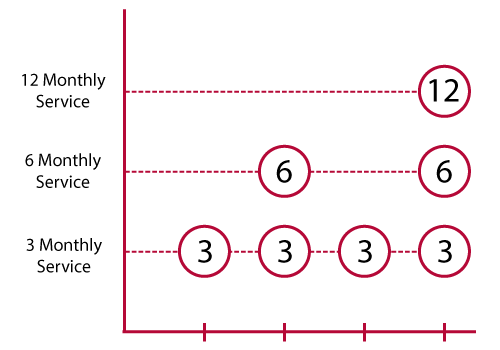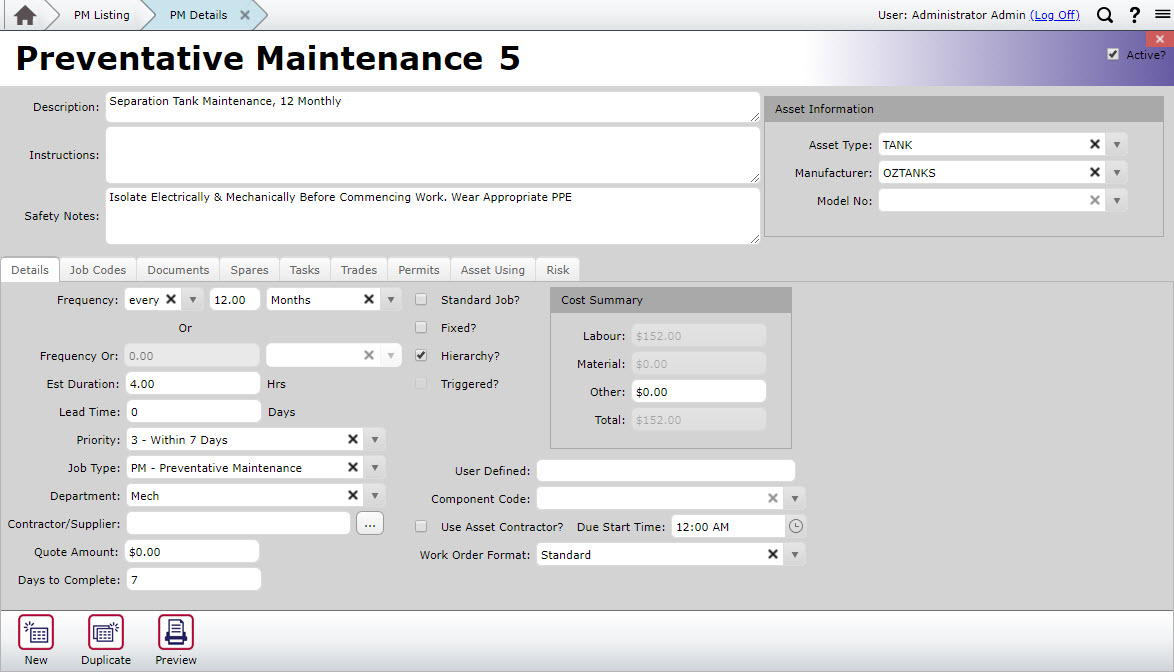
Troubleshooting Preventative Maintenance Hierarchies
Preventative Maintenance(PM) is a core module of the MEX Maintenance Software that when set up right will go a long way in dictating what maintenance work and at what frequency you are to carry out this work on your equipment. In MEX there are four types of PMs that help to determine these tasks and timings and understanding them is very important for getting your system to work as it should.
These four PM Types are:
- Fixed
- Hierarchy
- Triggered
- Standard Jobs
A full explanation of each of these preventative maintenance types can be found in an article we have prepared previously: Preventative Maintenance Types in MEX
In this article we will look at the Hierarchy Preventative Maintenance Type and provide you with some useful tips to troubleshooting your policies that are Hierarchy based.
Preventative Maintenance Hierarchies
Preventative Maintenance Hierarchies can be very useful for creating highly detailed maintenance schedules that require multiple policies. They help to capture the details of the work you need perform on particular assets at different frequencies.
For example, a conveyor system may have routine maintenance policies in three, six and twelve monthly intervals. The MEX Hierarchy will take these policies and queue each one as follows:
- At three months the three monthly service policy is used.
- At six months both the three and six monthly policies are up for use but because of the hierarchy suppression rules, only the six monthly policy will be used.
- At nine months only the three month policy will be used.
- And finally, at the 12 month mark, all policies will be due but due to suppression the 12 month policy will be used.

Without the right knowledge of how hierarchy’s work within MEX PM Policies, creating and maintaining these hierarchies can become confusing. If these are not set up correctly in the first place, MEX won’t generate Work Orders as expected.
If this is the case, there are some rules that can be followed to troubleshoot your policies and help you understand why your hierarchies aren’t working as expected.
Make Sure Hierarchy is ticked
Firstly, make sure that the ‘Hierarchy?’ box is ticked in each of the PM Details for all the PMs that have been included in the Hierarchy.
A policy will not suppress, or be suppressed by another policy if this box is not ticked.
NOTE: If a policy is ‘stand-alone’ (i.e. is not in a hierarchy), it’s a good idea to untick the hierarchy box so that it will not accidently suppress, or be suppressed by another policy.

The Hierarchy option is checked for this Preventative Maintenance Policy
Maintain the same Frequency Type across all policies in the hierarchy.
Ensure that all policies within the Hierarchy are using the same frequency type. For instance, when working with usage-based policies (Hours and km for example), a 250 Hr PM won’t suppress a 5000km PM. For time-based polices (i.e. Days, Weeks, Months and Years) the due dates calculated from time-based frequencies vary slightly depending on the frequency type selected. For example, a 1 weekly policy last done last Monday, will be next due next Monday, while a 1 monthly policy last done on the 1st June, will next be due on 1st July. The variance in the calculated due date is usually taken into account when it comes to suppression, but occasionally if the dates don’t quite line up then the suppression will fail.
To ensure that suppression always occurs, the best way is to use the same frequency types in time-based hierarchies.
All Frequency Numbers must be easily divisible.
You need to ensure that the frequencies that you choose to use on the policies within your hierarchy can be easily divisible. For example if a hierarchy sequence is to be 3, 6, 12, 15 Monthly, then the 15 Monthly policy will only be due at the same time as the 6 Monthly every 5 Years, with the 12 Monthly policy lining up every 10 Years, which can look like as if services have been skipped. The easiest way to manage this sequence is to have 12 months as your highest policy and have the 15 monthly PM set up as a ‘stand-alone’ policy (i.e. untick the hierarchy tick box).
All policies in hierarchy must belong to the same department
MEX groups Preventative Maintenance schedules into hierarches using the Department field. If one of the policies in the hierarchy has a different department (or no department) to the other policies, it will not be suppressed by the activator. For this reason a 12 monthly electrical service, shouldn’t suppress a 6 monthly mechanical service due around the same time.
The same Assets must be assigned to all policies in the hierarchy
If policy suppression isn’t working as expected, check to see if all policies in the hierarchy have the same assets on them. A work order will only supress or be suppressed if there is an asset to link the work order to.
Last Done Dates or Last Done Readings must all line up
The Preventative Maintenance schedules do not have to be due on exactly the same date for the Hierarchy to function. The margin used for Hierarchy calculation is dependent on the frequency of the Preventative Maintenance that is highest in the Hierarchy and can range from +/-25% to +/-5% of that Preventative Maintenances frequency.
Therefore, you must ensure that the Last Done Dates (for Time based policies), or Last Done Readings (for usage-based policies) line up (within approximately 20% of the policies interval) in order for suppression to take place. One of the reasons that policies sometimes don’t suppress is because they are calculated as being next due at different times and this will catch you out.
To be Fixed or not to be Fixed.
It is not mandatory to have your policies Fixed, but it is recommended. Having the Fixed option checked will go a long way in ensuring that work is scheduled on time and that there are no disruptions when it comes to activating the work orders for the policies in the hierarchy.
Take for example what happens when the policy is not fixed and you don’t close off your 3 monthly policy in a timely fashion (waiting for parts, lack of plant availability, forgot to etc…). It prevents your 6 monthly policy from raising and so on up the chain of policies in the Hierarchy. This is generally really bad and will have repercussions throughout your equipment’s maintenance regime if not captured early. Also, if the closed date is too far out of sequence (20% of higher frequency interval), then the suppressions will stop working altogether. If you’re having problems with hierarchy it’s almost always because you don’t have Fixed option ticked.
Having said that, it is important that after having checked all the criteria that makes the hierarchy work properly, the easiest way to make sure that the policies remain in the hierarchy is to tick the ‘fixed?’ checkbox on all PMs as well.
By following these troubleshooting techniques it ensures that your Preventative Maintenance policies run efficiently.
Any Questions?
If you have any questions about this article on Troubleshooting Hierarchy in MEX please contact the MEX Support team at support@mex.com.au or call +61 7 3392 4777.